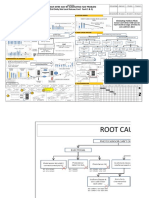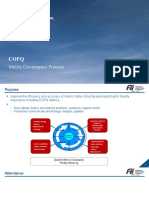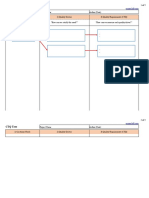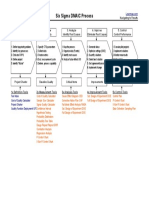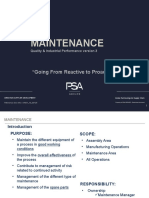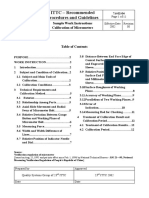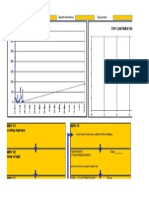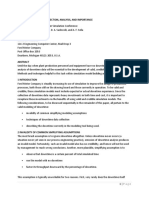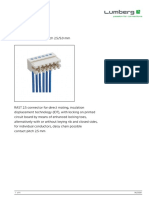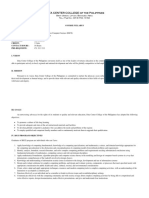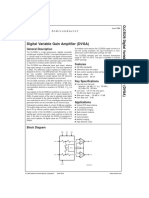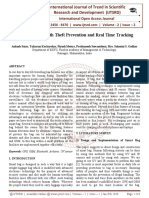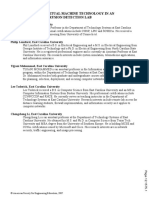Title: Assembly Line 3 Downtime reduction
A3 - Structured Problem Solving
ID: Sponsor: PM:
Project Team: S Johnson, M Williams, E, Smith, J Brown, L Miller Start Date: 10/29/2023 Last Updated: 11/14/2024
A. Describe Problem / Issue C. Solve Problem / Issue
1. Problem Description / Current Condition / Containment Actions 5. Corrective Action
3. Key-Questions Is Is Not
Over the past three months, machine downtime on Automotive Assembly
Line No.3 has increased by 30%. This has predominantly affected the What Increased Affecting all
assembly line workers and leads, leading to production delays and higher What is the machine machinery on
labor costs. problem/defect? downtime by 30% the floor
Current Condition:
Average downtime is currently 90 minutes per day per machine, causing a
delay in the production of approximately 40 cars per day. Where? Automotive Present in
Containment Actions:
assembly line assembly
Temporary overtime shifts have been added to meet production goals,
Where is the No.3 lines No.1 and
leading to an increase in labor costs. problem? No.2
2. Goal Statement / Target Condition When? Over the past 3 An issue that
months has been
Our goal is to achieve at least a 20% reduction in machine downtime on Automotive
Assembly Line No.3, lowering it from 90 minutes to no more than 72 minutes per day consistent
When is the problem
per machine, within the next 60 days. This will be accomplished through the observed over the
implementation of a weekly preventive maintenance schedule and upgrading critical years
machine components. This reduction is crucial for increasing productivity and reducing How? Through Through
labor costs, aligning with our overall business objectives.
interruptions in supply chain
the assembly or external
How is it a problem?
process factors
Who? Affects assembly Affecting
line workers and administrative
leads staff
Who is involved?
B. Find Root Cause of Problem / Issue D. Validate Solution and Standardize
4. Technical & Systemic Root Cause 6. Effect Confirmation
5 Whys Analysis for Lack of Assembly Line 3 Downtime (minutes)
Preventive Maintenance
1. Why are machines not serviced 90
regularly? 85
There is no established schedule for 80
preventive maintenance.
2. Why is there no established schedule 75
for preventive maintenance? 70
Management has not prioritized creating 65
a preventive maintenance plan. 60
3. Why has management not prioritized
creating a preventive maintenance plan? 55
They are under the impression that it 50
would be too costly and time-consuming. 45
4. Why do they think it would be too 40
costly and time-consuming? 0 0 0 0 0 0
There is a lack of data showing the long- 10 15 20 25 30 35
45 45 45 45 45 45
term benefits and cost-savings of
preventive maintenance. 7. Read Across / Preventive Action / Lessons Learned
5. Why is there a lack of data showing
the long-term benefits and cost-savings Lessons Learned:
of preventive maintenance? Cost of Inaction: Neglecting regular maintenance can lead to more significant downtimes and, in turn, higher costs in terms of production losses and emergency
The organization has not invested in repairs.
tracking this kind of data, focusing Training is Crucial: Ensuring that the maintenance team is well-trained and updated with the latest best practices is essential for machine longevity and optimal
performance.
instead on immediate, short-term gains. Data-Driven Decision Making: Using data to analyze the problem helped in understanding the gravity of the situation and drove the decision-making process.
Continuous monitoring post-implementation helped validate the effectiveness of the solutions.
Importance of Early Detection: By identifying and addressing potential issues early on, many machine-related problems can be nipped in the bud, preventing
larger, more costly issues down the line.
Stakeholder Buy-in: Securing management's buy-in was essential for the success of the preventive maintenance plan. Their support was crucial in terms of
resources, approvals, and company-wide implementation.
Continuous Improvement: Even after implementing solutions, the need for continuous review and improvement is paramount. What works today might need
adjustments tomorrow based on evolving business needs and challenges.
Learnleansigma.com
� Title:
A3 - Structured Problem Solving
ID: Sponsor: PM:
Project Team: Start Date: Last Updated: 11/14/2024
A. Describe Problem / Issue C. Solve Problem / Issue
1. Problem Description / Current Condition / Containment Act 5. Corrective Action
3. Key-Questions Is Is Not
What
What is the
problem/defect?
Where?
Where is the
problem?
2. Goal Statement / Target Condition When?
When is the problem
observed
How Big?
How many objects
have the problem?
Who?
Who is involved?
B. Find Root Cause of Problem / Issue D. Validate Solution and Standardize
4. Technical & Systemic Root Cause 6. Effect Confirmation
7. Read Across / Preventive Action / Lessons Learned
Learnleansigma.com






